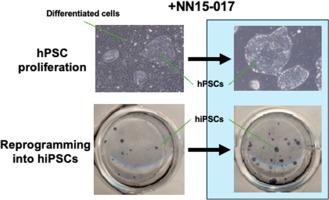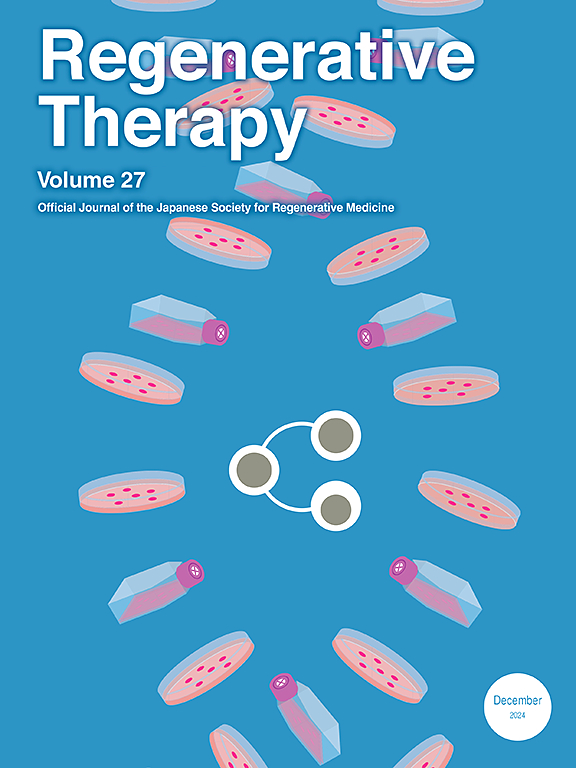NN15-017 promotes human pluripotent stem cell proliferation and generation
IF 3.5
3区 环境科学与生态学
Q3 CELL & TISSUE ENGINEERING
引用次数: 0
Abstract
Introduction
The nutrient requirements for culturing human pluripotent stem cells (hPSCs) have been studied in relation to the development of chemically defined media. Most hPSC media contain FGF2, which is critical for hPSC growth and maintenance. Here, we investigated compounds that could substitute for FGF2 activity.
Methods
To identify compounds that can replace FGF2 and promote the proliferation of undifferentiated hPSCs, we screened our compound library using the hOCT4-EGFP reporter system and evaluated candidates using cell morphological analysis and OCT4 immunostaining as a marker of undifferentiated cells. We further evaluated the extent to which the selected compound can replace FGF2 through long-term culture (over 10 passages). We examined whether the compounds promote the reprogramming efficiency of somatic cells into induced pluripotent stem cells (iPSCs) using mRNA reprogramming. We also analyzed which signaling pathways were activated by the compound using western blotting.
Results
We identified a new compound, NN15-017, which enables a reduced concentration of FGF2 in the medium by 5-fold and enhances the reprogramming efficiency of human induced PSCs by 2- to 3-fold. NN15-017 promoted the MAP/ERK signaling pathway downstream of FGF2 and may affect the Hippo-YAP signaling pathway in hPSCs.
Conclusions
NN15-017 reduces the requirement for FGF2, thereby providing novel and valuable benefits for the proliferation and generation of human induced PSCs.

NN15-017促进人类多能干细胞的增殖和生成
培养人多能干细胞(hPSCs)的营养需求已经研究了与化学定义培养基的发展有关的问题。大多数hPSC培养基含有FGF2,它对hPSC的生长和维持至关重要。在这里,我们研究了可以替代FGF2活性的化合物。方法为了鉴定能够替代FGF2并促进未分化hPSCs增殖的化合物,我们使用hOCT4-EGFP报告系统筛选化合物库,并使用细胞形态学分析和OCT4免疫染色作为未分化细胞的标记来评估候选化合物。我们进一步评估了所选化合物通过长期培养(超过10传代)替代FGF2的程度。我们研究了这些化合物是否通过mRNA重编程促进体细胞向诱导多能干细胞(iPSCs)的重编程效率。我们还使用western blotting分析了哪些信号通路被化合物激活。结果我们发现了一种新的化合物NN15-017,它能使培养基中FGF2的浓度降低5倍,使人诱导的PSCs的重编程效率提高2- 3倍。NN15-017促进了FGF2下游的MAP/ERK信号通路,并可能影响hPSCs中的Hippo-YAP信号通路。结论snn15 -017降低了对FGF2的需求,从而为人诱导的PSCs的增殖和生成提供了新的有价值的益处。
本文章由计算机程序翻译,如有差异,请以英文原文为准。
求助全文
约1分钟内获得全文
求助全文
来源期刊

Regenerative Therapy
Engineering-Biomedical Engineering
CiteScore
6.00
自引率
2.30%
发文量
106
审稿时长
49 days
期刊介绍:
Regenerative Therapy is the official peer-reviewed online journal of the Japanese Society for Regenerative Medicine.
Regenerative Therapy is a multidisciplinary journal that publishes original articles and reviews of basic research, clinical translation, industrial development, and regulatory issues focusing on stem cell biology, tissue engineering, and regenerative medicine.
 求助内容:
求助内容: 应助结果提醒方式:
应助结果提醒方式:


